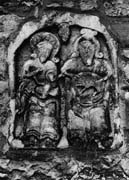Select a site alphabetically from the choices shown in the box below. Alternatively, browse sculptural examples using the Forward/Back buttons.
Chapters for this volume, along with copies of original in-text images, are available here.
Object type: Shaft fragment or plaque [1]
Measurements: H. 57 cm (22.5 in) W. 46 > 44.8 cm (18.1 > 17.6 in) D. Built in
Stone type: Medium-grained oolitic dolomitic limestone with micritic matrix. Pale yellow (2.5YR 8/4). This stone type is commonly used in the Hartlepool area of co. Durham (Hartlepool and Roker Dolomite, Upper Permian): see Chap. III, p. 15. This suggests that the sculpture in question may have been imported into the Priory site.
Plate numbers in printed volume: Ill. 653
Corpus volume reference: Vol 6 p. 179-180
(There may be more views or larger images available for this item. Click on the thumbnail image to view.)
A (broad) : The edge mouldings are rolled and form a round-headed arch to frame the panel, though without any vestige of capitals to the flanking uprights other than faint incisions. From the crest of the arch hangs a pendant animal head with pricked, gouged ears against a short mane, incised elliptical eyes in a broad brow, and a pointed jowl. Within the arch sit two figures with scrolled haloes. The left-hand figure inclines his head towards the other and his dished nimbus carries a run of incised chevrons. The face has a pointed chin, large eyes and softly modelled features, and a mouth dipped at the corners. The figure is clothed in a long gown to the ankles. The rounded shoulders have lost their surface detail. The spindly arms emerge from ribbed semicircular folds with tiny hands, one of which holds the adjacent figure by the elbow. The knees are held together, surmounted by the modelled fold of the overgarment, dipping between the knees and falling on each side in a modelled fold to meet the raised hem which arches over each small foot. Across this figure's lap lies a supine figure about half the size of the seated one. It wears a long ankle-length robe and the legs dangle on the left. The arms are curvilinear and the pear-shaped head small. This smaller figure grasps the wrist of the larger one with its right hand, and points with a small wand to an open book on its own lap. The two seated figures are separated by a short column stemming from a plain conical base; parts of two other bases, very worn, occupy the lower corners. The right-hand seated figure has a scrolled halo with an erupting pair of scrolls at its crest. The nimbus is dished. The features are similar to the left-hand figure's but the chin is more spade-shaped. The drapery is identical too, though concentric rib folds survive on the shoulders. The spindly hands hold a dished circular platter on the lap; it frames a naturalistic profile animal facing left, with incised eye and perhaps a horn or short mane. The lower drapery of the figure is like the other's, the modelled fold framing each shin.
This is a unique piece. The figures are very probably two of the Evangelists holding their symbols on their laps, that on the left St Matthew, the companion either St Mark or St Luke, depending on the interpretation of the animal as a lion or a bull. The unusual position of the symbols in the laps of the Evangelists does not have any extant earlier or contemporary parallels. It is found in the Romanesque carving of the Second School of Languedoc where the signs of the Zodiac occupy a similar position, but that dates from a century later than the Newburgh piece (Salvini 1969, pl. 89, 322).
The scrolled haloes derive from monuments such as Nunburnholme 1, both first and second sculptors (Lang 1977, 75–94; id. 1991, 189–93, ills. 723–4), Old Malton 1 (id. 1991, 196–7, ill. 735), and the great cross in Leeds parish church (Collingwood 1915, 211–15; McGuire and Clark 1987, 13, fig. 6). By far the closest parallel, however, is the shaft at Shelford, Nottinghamshire (Hill 1916, 203, pl. II; Kendrick 1949, 78–9, pl. LI), which displays an identical halo on the inclined head of Our Lady, heavily stylised ribbed drapery in parallel folds, scrolled flourishes, and, most significantly, small thin arms protruding from heavily draped shoulders.[2] Perhaps caution should be exercised in seeking a link between the two sites, for the Newburgh Priory wall that contains the carving has a range of sculptural fragments from many periods and may represent a collection acquired from a variety of sources or agents.
The drapery folds about the legs are proto-Romanesque, delineating anatomical zones in the manner of a similar arched plaque at Sompting, Sussex (Lang 1988a, 52–3, pl. 28; Tweddle et al. 1995, 178–9, ill. 181), which tends to advance the date into the early eleventh century. A second feature which supports such a date, when growing naturalism regained ground from formalised or stiff figures, is the touching or holding of one person by another, and the gently bowing head.
Sculpture of this kind and period is rare in Yorkshire as a whole, and it is unfortunate that the provenance of the piece cannot be more surely defined.
[1] The following is an unpublished manuscript reference to no. 1: London, Society of Antiquaries, MS 903/4/1, pp. 4, 5–6 (Galbraith papers).
[2] This interesting parallel suggests an alternative interpretation of the two figures, as the Virgin Mary and Christ in Majesty, she with the Christ child on her lap, he with the Lamb in a medallion, reflecting his dual nature. (D.C.)



